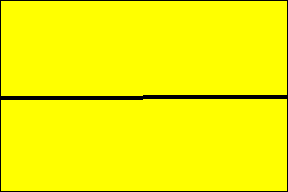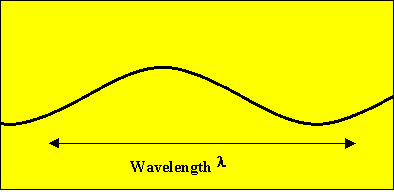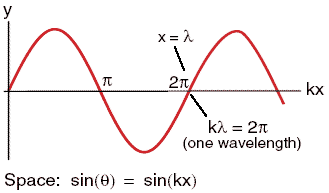

|
A wave pulse is a disturbance that moves through a medium. A periodic wave is a periodic disturbance that moves through a medium. The medium itself goes nowhere. The individual atoms and molecules in the medium oscillate about their equilibrium position, but their average position does not change. As they interact with their neighbors, they transfer some of their energy to them. The neighboring atoms in turn transfer this energy to their neighbors down the line. In this way the energy is transported throughout the medium, without the transport of any matter. |
 |
|
| The animation on the right portrays a medium as a series of particles connected by springs. As one individual particle is disturbed, and then returns to its initial position, it transmits the disturbance to the next interconnected particle. This disturbance continues to be passed on to the next particle. The result is that energy is transported from one end of the medium to the other end of the medium without the actual transport of matter. Each particle returns to its original position. |  |
|
|
 |
|
|
Problem:
Problem:
|
 |
| If the displacement of the individual atoms or molecules is perpendicular to the direction the wave is traveling, the wave is called a transverse wave |
|
|
| If the displacement is parallel to the direction of travel the wave is called a longitudinal wave or a compression wave. |
|
|
| Transverse waves can occur only in solids, whereas longitudinal waves can travel in solids, fluids, and gases. Transverse motion requires that each particle drag with it adjacent particles to which it is tightly bound. In a fluid this is impossible, because adjacent particles can easily slide past each other. Longitudinal motion only requires that each particle push on its neighbors, which can easily happen in a fluid or gas. The fact that longitudinal waves originating in an earthquake pass through the center of the earth while transverse waves do not is one of the reasons the earth is believed to have a liquid outer core. | Link: | |
|

|
To visualize the traveling wave, download this Excel spreadsheet. Macros must be enabled. (Click the developer tab and choose macro security, disable all macros with notification. A security warning will then pop up when you open the spreadsheet and you can choose the option to enable the content. If the developer tab is not available, click the file tab, options, customize ribbon. and under main tabs, select the developer check box.)
The amplitude A of a wave is the maximum displacement of the individual particles from their equilibrium position. The energy E carried by a wave is proportional to the square of its amplitude.
E is proportional to A2
The power P or energy per unit time delivered by the wave if it is absorbed is proportional to the square of its amplitude times its speed.
P is proportional to A2v
Link:
Two or more waves traveling in the same medium travel independently and can pass through each other. In regions where they overlap we only observe a single disturbance. We observe interference. When two or more waves interfere, the resulting displacement is equal to the vector sum of the individual displacements. If two waves with equal amplitudes overlap in phase, i.e. if crest meets crest and trough meets trough, then we observe a resultant wave with twice the amplitude. We have constructive interference. If the two overlapping waves, however, are completely out of phase, i.e. if crest meets trough, then the two waves cancel each other out completely. We have destructive interference.
Link: